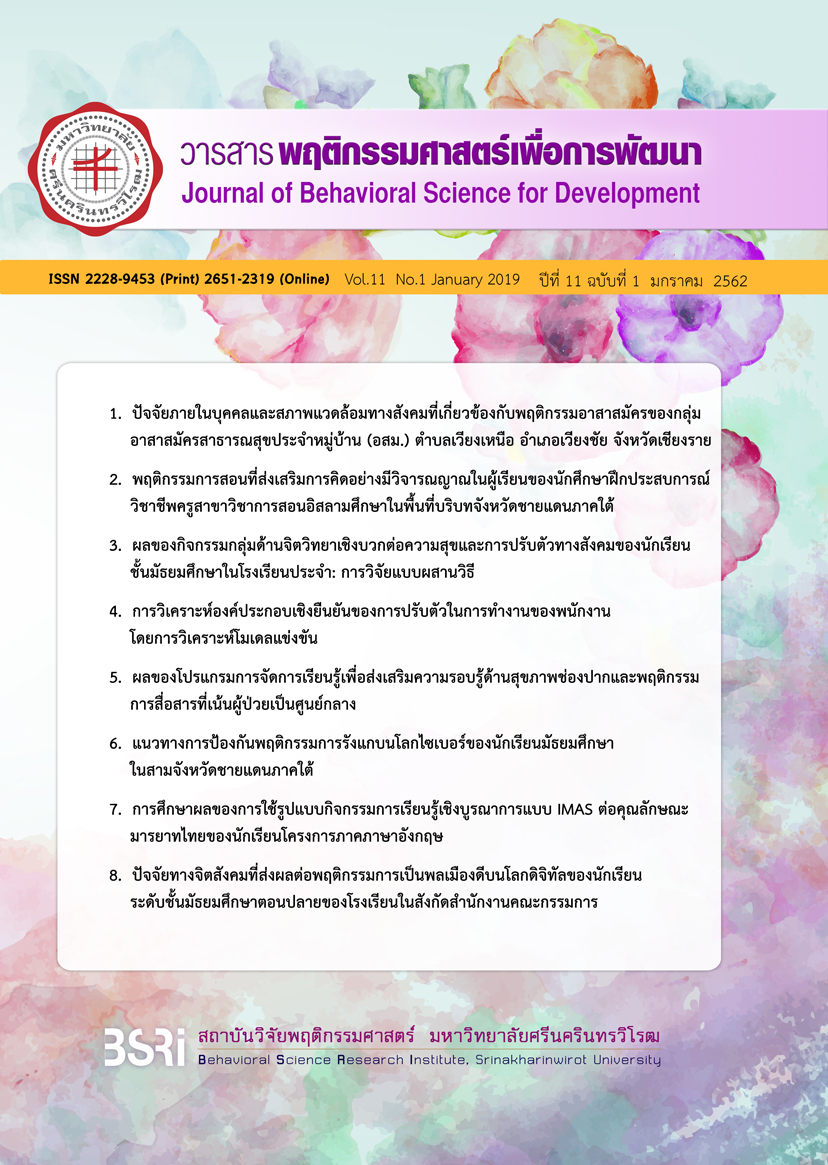พฤติกรรมการสอนที่ส่งเสริมการคิดอย่างมีวิจารณญาณของผู้เรียน ตามการรับรู้ของนักศึกษาฝึกประสบการณ์วิชาชีพครูสาขาวิชาการสอนอิสลามศึกษาและครูอิสลามศึกษาในพื้นที่บริบทจังหวัดชายแดนภาคใต้
Keywords:
Teaching Behavior, Critical Thinking, Pre-service Teacher, Teaching Islamic Studies.Abstract
This research aimed to obtain the perception of Teaching Islamic Studies pre-service and Islamic Studies teachers on teaching behaviors to encourage students’ critical thinking skills and the related conditions of teaching behaviors. Group discussion and the in-depth interview were used in this qualitative study. Eight students (Key informants) and three teachers (Secondary informants) were purposively selected from three universities including, Prince of Songkla University Pattani Campus, Fatoni University and Yala Rajabhat University and three public schools respectively. The study revealed that teaching behaviors to encourage students’ critical thinking skills can be classified into three main categories namely teaching behaviors, including; pre-class activities; implementing classroom activities to promote thinking skills; encouraging students to create their own instructional media; engaging students in learning, and using open-ended questions. Furthermore, organizational behaviors, including; teacher-student after the class meeting; the frequency of changing the classroom environment, lastly, helping students on the extra classes. In additional, the third category was Socio-emotional behaviors consist of; teachers' self and emotion regulation, considering the student nature and background and having a good relationship with the colleagues. Thus, there were two categories of the conditions related to teaching behaviors namely, internal conditions including; teacher self-learning; the teacher characteristics and the student characteristics. Moreover, external conditions including; the classroom courses in the university; the seminar during the student teaching practice; the teaching practice experience; the university supervisor; having the role model; the mentor teacher; the family members’ support; the training on the teaching in the 21st century; the school and the community environment.
References
จิตราภรณ์ พงษ์มาลี. (2550). การศึกษาความสัมพันธ์ระหว่างพฤติกรรมการสอนของครูกับความสามารถในการคิดอย่างมีวิจารณญาณของนักเรียนชั้นประถมศึกษาปีที่ 6 สังกัดสำนักงานเขตพื้นที่การศึกษานครราชสีมา เขต 6. (การศึกษามหาบัณฑิต), มหาวิทยาลัยศรีนครินทรวิโรฒ, กรุงเทพฯ.
จินดา ทัพจีน. (2546). พฤติกรรมการสอนของครูที่เน้นผู้เรียนเป็นสำคัญ โรงเรียนขยายโอกาสทางการศึกษา สังกัดกรุงเทพมหานคร : กรณีศึกษากลุ่มกรุงธนเหนือ. (การศึกษามหาบัณฑิต), มหาวิทยาลัยศรีนครินทรวิโรฒ, กรุงเทพฯ.
ชาย โพธิสิตา. (2554). ศาสตร์และศิลป์แห่งการวิจัยเชิงคุณภาพ (พิมพ์ครั้งที่ 5). กรุงเทพฯ: บริษัทอมรินทร์พริ้นติ้งแอนด์พับลิชชิ่ง จำกัด (มหาชน).
ทิศนา แขมมณี. (2560). ศาสตร์การสอน องค์ความรู้เพื่อการจัดกระบวนการเรียนรู้ที่มีประสิทธิภาพ (พิมพ์ครั้งที่ 20). กรุงเทพฯ: สำนักพิมพ์แห่งจุฬาลงกรณ์มหาวิทยาลัย.
สถาบันทดสอบทางการศึกษาแห่งชาติ. (2553). วิกฤตการศึกษาไทย ชี้ด้วย O-NET, I-NET, V-NET, U-NET, N-NET GAT และ PAT. กรุงเทพฯ: สถาบันทดสอบทางการศึกษาแห่งชาติ (องค์การมหาชน).
สำนักงานเลขาธิการสภาการศึกษา. (2552). นโยบายหลักเพื่อขับเคลื่อนการปฏิรูปการศึกษาในทศวรรษที่สอง (พ.ศ. 2554-2561). กรุงเทพฯ: สำนักงานเลขาธิการสภาการศึกษา.
สำนักงานเลขาธิการสภาการศึกษา. (2560). แผนการศึกษาแห่งชาติ พ.ศ. 2560-2579. กรุงเทพฯ: บริษัท พริกหวานกราฟฟิค จำกัด.
สุภางค์ จันทวานิช. (2554). การวิเคราะห์ข้อมูลในการวิจัยเชิงคุณภาพ (พิมพ์ครั้งที่ 10). กรุงเทพฯ: สำนักพิมพ์แห่งจุฬาลงกรณ์มหาวิทยาลัย.
Ajzen, I. (2002). Perceived behavioral control, self‐efficacy, locus of control, and the theory of planned behavior 1. Journal of applied social psychology, 32(4), 665-683.
Bellanca, J., & Brandt, R. (2010). 21st century skills: Rethinking how students learn. IN: Solution Tree Press.
Elder, L., & Paul, R. (2012). 30 Days to Better Thinking and Better Living Through Critical Thinking: A Guide for Improving Every Aspect of Your Life, Revised and Expanded. NY: Pearson Education.
Fahim, Mansoor Masouleh, & Shakouri, N. (2012). Critical thinking in higher education: A pedagogical look. Theory and practice in language studies, 2(7), 1370.
Fisher, R. (2001). Philosophy in primary schools: fostering thinking skills and literacy. Reading, 35(2), 67-73.
Halim, L., Meerah, T. S. M., & Buang, N. A. (2010). Developing pre-service science teachers’ pedagogical content knowledge through action research. Procedia-Social and Behavioral Sciences, 9, 507-511.
Hein, V. (2012). The effect of teacher behaviour on students motivation and learning outcomes: a review. Acta Kinesiologiae Universitatis Tartuensis, 18, 9-19.
Krathwohl, D. R. (2002). A revision of Bloom's taxonomy: An overview. Theory into practice, 41(4), 212-218.
Kyriakides, L., Creemers, B. P., & Antoniou, P. (2009). Teacher behaviour and student outcomes: Suggestions for research on teacher training and professional development. Teaching and teacher education, 25(1), 12-23.
Lai, E. R. (2011). Critical thinking: A literature review. Pearson's Research Reports, 6, 40-41.
Lewis, A., & Smith, D. (1993). Defining higher order thinking. Theory into practice, 32(3), 131-137.
Nair, S., & Ngang, T. K. (2012). Exploring Parents’ and Teachers’ Views of Primary Pupils’ Thinking Skills and Problem Solving Skills. Creative Education, 3(01), 30.
O Nyumba, T., Wilson, K., Derrick, C. J., & Mukherjee, N. (2018). The use of focus group discussion methodology: Insights from two decades of application in conservation. Methods in Ecology and Evolution, 9(1), 20-32.
Palys, T. (2008). Purposive Sampling. In L. M. Given (Ed.), The Sage encyclopedia of qualitative research methods. California: Sage Publications.
Partnership for 21st Century Skills. (2008). 21st Century Skills, Education & Competitiveness: A Resource and Policy Guide. AZ: Partnership for 21st Century Skills.
Pössel, P., Rudasill, K. M., Adelson, J. L., Bjerg, A. C., Wooldridge, D. T., & Black, S. W. (2013). Teaching behavior and well-being in students: Development and concurrent validity of an instrument to measure student-reported teaching behavior. International Journal of Emotional Education, 5(2), 5.
Reja, U., Manfreda, K. L., Hlebec, V., & Vehovar, V. (2003). Open-ended vs. close-ended questions in web questionnaires. Developments in applied statistics, 19, 159-177.
Siedlaczek, K. (2004). Perceptions about teaching online versus in a classroom environment. College Quarterly, 7(3), n3.
Sternberg, R. J. (1985). Beyond IQ: A triarchic theory of human intelligence. NY: Press Syndicate of the University of Cambridge.
Zemelman, S., Daniels, H., & Hyde, A. (2005). Best Practice Today’s Standards for Teaching and Learning in America’s Schools (Third Edition ed.). Portsmouth, New Hampshire: Heinemann.




